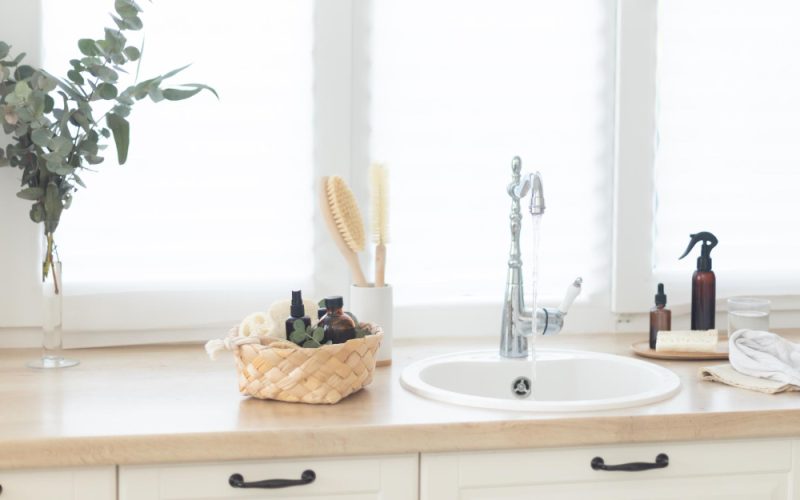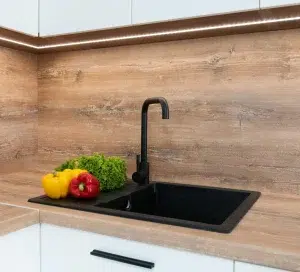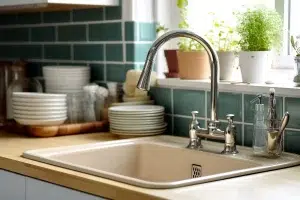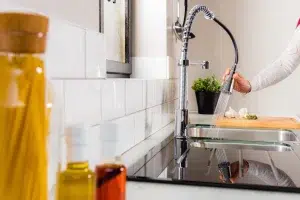Atualizando seu banheiro instalando um nova vaidade pode refrescar todo o visual do espaço. No entanto, remover a penteadeira existente e colocar uma substituta dá um certo trabalho. Em poucas palavras, o processo envolve preparação, desmontagem da penteadeira antiga, instalação da nova e retoques finais.
Desmontar a penteadeira antiga vem em seguida, exigindo que você desconecte os canos de drenagem e remova as bancadas e os armários. Instalar a penteadeira nova é essencialmente reverter esse processo após um posicionamento cuidadoso.
Este guia divide o processo em etapas gerenciáveis que qualquer um pode seguir. Vamos começar revisando tudo o que você precisa fazer para se preparar para a remoção e substituição da vaidade.
Índice
AlternarTrabalho de preparação – Primeiro passo
Substituir uma penteadeira de banheiro requer alguma preparação inicial antes de começar a desmontar a antiga. O planejamento adequado torna o processo de instalação mais tranquilo. Aqui estão as principais tarefas de preparação:
- Determinar novas dimensões de vaidade
Tire medidas da penteadeira e do espaço existentes para ajudar a selecionar um modelo de substituição adequado. As larguras padrão são geralmente 24”, 30”, 36” e 48”. Certifique-se de levar em conta os locais de encanamento em relação à nova pegada da penteadeira. Considere também o fluxo de tráfego ao redor de portas e janelas ao dimensionar.
- Montar materiais e ferramentas
Você precisará de ferramentas básicas de bricolage, como uma alavanca, martelo, conjunto de chaves de fenda, nível, fitas métricas, etc. Tenha materiais em mãos para instalar a nova penteadeira, como parafusos, suportes, calafetagem de silicone e selante. Equipamentos de segurança, como luvas e proteção para os olhos, também são uma boa ideia.
- Desligue as linhas de abastecimento de água
Localize as válvulas de corte abaixo ou atrás da penteadeira existente e gire-as no sentido horário para interromper o fluxo de água. Isso evita vazamentos enquanto você desconecta o encanamento. Desligue o disjuntor de alimentação se remover acessórios elétricos também.
- Prepare a nova vaidade
Inspecione sua penteadeira de substituição[1] antes do dia da instalação – todas as peças estão presentes? Pré-fixe os suportes de montagem nas laterais do gabinete para uma montagem mais rápida. Desembale-o perto da porta do banheiro para fácil acesso.
- Proteja pisos e paredes
Coloque lonas de proteção no espaço de trabalho para proteger contra arranhões ou danos causados pela água durante o processo. Você também pode querer remover o acabamento do rodapé para simplificar a instalação.
- Trabalho em Seções
Lidar com uma peça de cada vez em estágios coordenados torna o gerenciamento de uma substituição de penteadeira de banheiro muito menos trabalhoso. Mantenha caminhos de acesso limpos ao redor do espaço de trabalho o tempo todo.
Como desmontar a penteadeira do banheiro?

Aqui estão os passos para desmontar um móvel de banheiro existente:
- Desconecte as linhas de encanamento
Feche as válvulas de fornecimento de água quente e fria localizadas sob a penteadeira. Desconecte o cano de drenagem primeiro – coloque um balde embaixo para coletar água, depois afrouxe a porca deslizante que conecta o cano ao tubo de drenagem na parede. Desconecte e remova as mangueiras de fornecimento em seguida. Tampe todos os canos abertos temporariamente.
- Remover espelho/armário de remédios
Retire cuidadosamente qualquer espelho montado na penteadeira ou armário de remédios usando uma alavanca. Insira calços atrás para evitar danos ao retirá-lo da parede. Apoie o peso enquanto remove completamente os parafusos ou o adesivo.
- Retire os azulejos do backsplash
Raspe toda a calafetagem e rejunte antigos com uma serra de rejunte. Comece a retirar os azulejos um por um usando uma espátula, trabalhando metodicamente a partir de uma borda ou canto. Proteja o drywall atrás para evitar grandes remendos mais tarde. Empilhe os azulejos ordenadamente para possível reutilização.
- Pia/bancada elevável
Se a pia e a bancada forem peças separadas, solte os clipes, as contas de calafetagem ou qualquer ferragem como torneiras que as ancorem juntas. Levante cuidadosamente a penteadeira do banheiro com a pia e solte quaisquer peças de drenagem restantes. Para uma parte superior sólida de uma peça, corte o perímetro da calafetagem com uma faca antes de tentar removê-la.
- Remover armário de toucador
Como remover uma penteadeira de banheiro? Retire todas as gavetas ou bandejas removíveis e, em seguida, localize os parafusos de montagem ou pregos que prendem o gabinete principal à parede. Remova esses fixadores mecânicos sistematicamente. Peça para ajudantes levantarem o gabinete liberado diretamente para fora através da porta, sem tombar ou torcer, para evitar danos.
- Limpar o espaço de trabalho
Inspecione se há algum cano de encanamento, âncoras de parede ou fragmentos de azulejos. Remova a calafetagem restante e aspire todos os detritos. Resolva qualquer dano significativo na parede de gesso exposta atrás da penteadeira antiga. Seu banheiro agora está preparado e vazio para a próxima penteadeira que está chegando.
Como instalar um móvel para banheiro?
Aqui estão as principais etapas envolvidas na instalação do móvel do banheiro:
- Posicione a vaidade
Carregue cuidadosamente a nova penteadeira para o lugar, centralizada nas vigas da parede. Use calços sob a base para nivelá-la da esquerda para a direita e da frente para trás. Certifique-se de que as portas e gavetas tenham folga.
- Proteja o Gabinete
Faça furos piloto através do painel traseiro ou dos suportes laterais nas vigas da parede. Fixe o gabinete usando parafusos longos. Aperte-os incrementalmente para puxá-lo firmemente para a parede.
- Engate a tubulação de drenagem
Conecte o ralo da pia da vaidade ao tubo de drenagem na parede usando uma porca deslizante, ajustando o comprimento do corte da peça traseira conforme necessário. Confirme se os encaixes estão apertados o suficiente para não vazar, mas ainda permitem ajuste.
- Conectar linhas de abastecimento de água
Conecte tubos flexíveis de fornecimento de água às válvulas de corte e entradas de torneira usando conexões de compressão. Certifique-se de conectar as linhas quente e fria corretamente em ambas as extremidades.
- Aplicar calafetagem e selante
Passe uma camada de calafetagem de silicone ao redor do tampo e da base da penteadeira, onde eles encontram a parede. Alise a calafetagem com um dedo molhado para um acabamento limpo. Deixe curar completamente durante a noite.
- Ligue a água novamente
Reabra as válvulas de corte de água quente e fria. Verifique embaixo dos armários com lanternas, procurando por gotejamentos em uniões de suprimento, porcas de deslizamento de drenagem, etc. Aperte se houver qualquer vazamento.
- Teste e conclua a instalação
Abra a torneira e deixe a água correr por alguns minutos para limpar quaisquer detritos e verificar se há vazamentos. Adicione quaisquer toques finais como gavetas, espelhos, iluminação e backsplash.
Conclusão
Atualizar seu banheiro com uma nova penteadeira pode atualizar a aparência ou ganhar espaço de armazenamento necessário. Mas instalar uma corretamente ajuda a garantir que a aparência renovada e a organização organizada durem por muitos anos. Siga uma boa preparação, técnicas de remoção cuidadosas, dicas de instalação de especialistas e métodos de teste completos
Para uma substituição de vaidade DIY suave e segura, apoiada por informações profissionais, confira De Wangle guias detalhados de remodelação de banheiros. Suas instruções ilustradas o guiam pelos principais passos, ao mesmo tempo em que mostram armadilhas a serem evitadas.
Perguntas frequentes – FAQs
Você mesmo pode instalar um móvel para banheiro?
Sim, com alguma experiência em DIY, as ferramentas certas e seguindo bons guias de instalação de armários de banheiro, muitos proprietários podem encarar um projeto de substituição de penteadeira de banheiro por conta própria. O processo envolve fechar as linhas de água, remover a penteadeira antiga, colocar a nova no lugar, conectar o encanamento e finalizar.
Como fixar um móvel de banheiro na parede?
Uma penteadeira de banheiro deve ser firmemente parafusada nas vigas da estrutura da parede para estabilidade. Localize as vigas usando um localizador de vigas. Segure a penteadeira no lugar desejado, marque os locais das vigas no painel traseiro e, em seguida, faça furos prévios. Use parafusos longos de madeira galvanizada através dos suportes traseiros nas vigas da parede.
O móvel do banheiro deve ser parafusado na parede?
Sim, parafusar através do suporte da penteadeira na estrutura de pinos da parede fornece suporte estrutural essencial. Depender somente de suportes laterais ou pendurar armários diretamente em furos de parafusos antigos corre o risco de a unidade se soltar gradualmente com o tempo.




